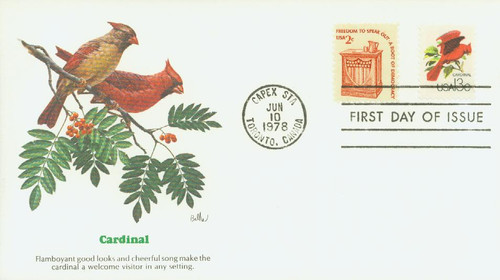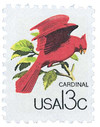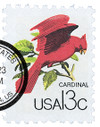
1978 13c Wildlife from Canadian/US Border,Cardinal
# 1757a - 1978 13c Wildlife from Canadian/US Border - Cardinal
$0.50 - $3.20
U.S. #1757a
1978 13¢ CAPEX Wildlife
Issue Date: June 10, 1978
City: Toronto, Canada
Quantity: 15,170,400
Quantity: 15,170,400
Printed By: Bureau of Engraving and Printing
Printing Method: Lithographed, engraved
Perforations: 11
Color: Multicolored
Issued in conjunction with the 1978 Canadian Philatelic Exhibition in Toronto, the CAPEX souvenir sheet was the first U.S. souvenir sheet to be released outside the country. Eight different stamps, featuring popular animals and birds from North America, appeared together on one colorful sheet.
Known for their colorful plumage and cheerful, flute-like songs, the cardinal is a popular sight at back yard bird feeders. At one time, these birds were trapped and sold as songbirds, and their feathers were used to decorate women’s hats. Today, cardinals are protected by law.
U.S. #1757a
1978 13¢ CAPEX Wildlife
Issue Date: June 10, 1978
City: Toronto, Canada
Quantity: 15,170,400
Quantity: 15,170,400
Printed By: Bureau of Engraving and Printing
Printing Method: Lithographed, engraved
Perforations: 11
Color: Multicolored
Issued in conjunction with the 1978 Canadian Philatelic Exhibition in Toronto, the CAPEX souvenir sheet was the first U.S. souvenir sheet to be released outside the country. Eight different stamps, featuring popular animals and birds from North America, appeared together on one colorful sheet.
Known for their colorful plumage and cheerful, flute-like songs, the cardinal is a popular sight at back yard bird feeders. At one time, these birds were trapped and sold as songbirds, and their feathers were used to decorate women’s hats. Today, cardinals are protected by law.











